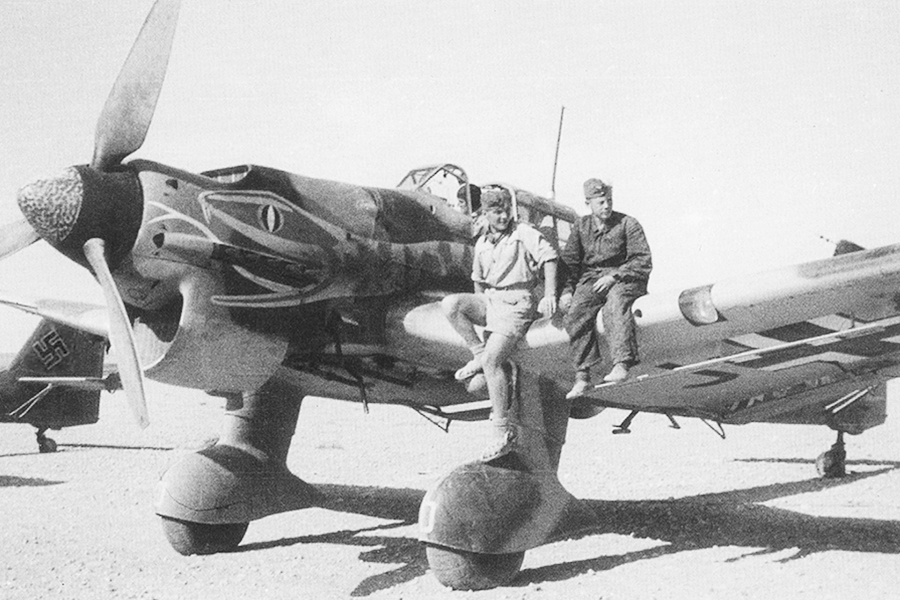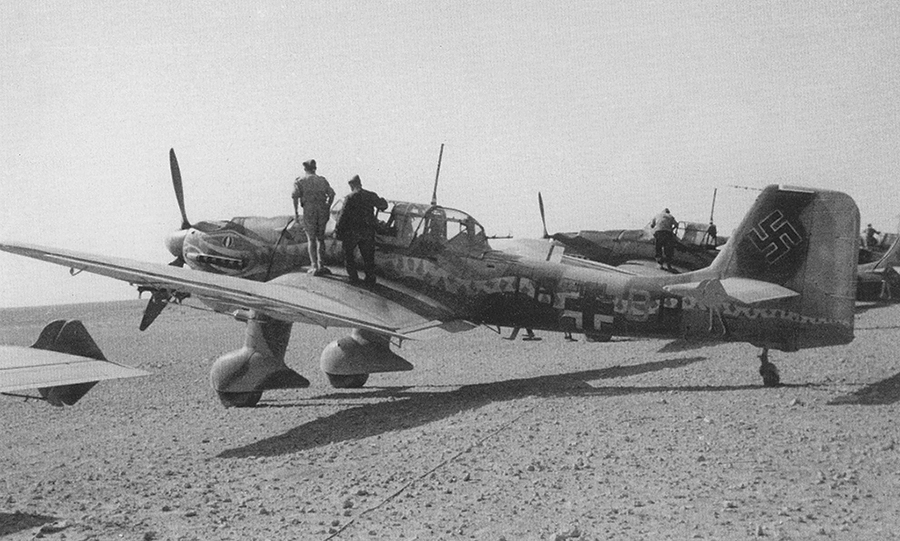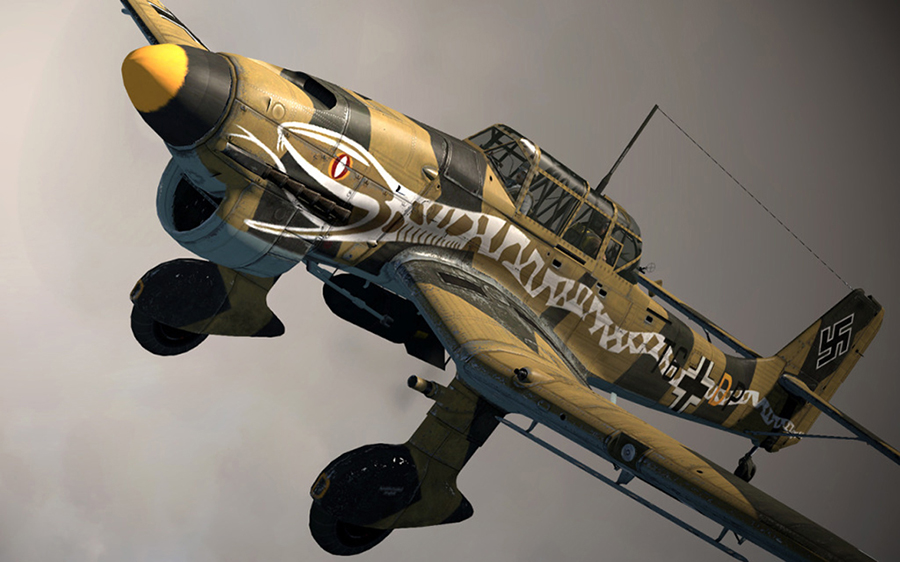
Discounting frames from a 1941 newsreel, the first photograph of the "Snake" Stuka was published by Ries in 1976. He identified the plane as an extended range Ju 87R (Reichweite) but did not hazard a guess as to the unit, remarking only on the contrast between RLM 79 and RLM 80 in the camouflage pattern. The picture was small and republished several years later in a much larger but slightly cropped format (above) by Held and Obermaier, who correctly surmised that the plane belonged to 6./St.G 2 and further posited that it had the individual aircraft letter "C" and was piloted by Leutnant Hubert Pölz. Only the front of the plane forward of the cockpit was visible, however, and for the next thirty years profilers and modelers would speculate as to the overall appearance of this, the most colorful and best known of all Stukas.

It was not until 2005, in an article by Urbanke, that newly published photographs allowed the plane to be correctly identified. The unit code was not T6+CP but T6+DP, as can be seen on both of the wheel fairings in the picture above. (Curiously, unless it is a typographical error, Franks, who had seen at least one of these photographs, also thought the plane to be T6+CP.) And the snake, rather than being red and white as so often depicted, was seen to have a more subdued sand color—reasonably so, given that such a gaudy creature hardly would have enhanced the camouflage of the plane.
Notice the hand-cranked inertia starter in front of the inverted gull wing and the mottled tip of the spinner. The "J" under the port wing is part of the factory registration code (Stammkennzeichen) assigned during construction, which sometimes was left on the underside of the wings even after the operational code (Verbandskennzeichen) had been applied.

In this picture, the identifying letter of the plane ("D") is readily visible. It is yellow (the color of the Staffel), which is repeated on the propeller spinner. To make the trailing edge of the tail appear smaller, Urbanke suggests that rudder was painted the same RLM 65 light blue as the undercarriage, whereas the difference in shading more likely is the shadow cast by the rudder having been turned slightly to port.

The Ju 87R-2 Trop belonged to St.G 2, which had been transferred to Libya in mid-February 1941 and stationed on the coast at Tmimi west of Tobruk (which, just three months later, it subjected to constant air attack in support of Erwin Rommel's newly formed Afrika Korps (as imagined in the reconstruction above). Allied convoys passing through the Straits of Gibraltar on their way to Malta and Alexandria also were heavily bombed.
The R-2 sub-variant had internal fuel tanks in the inner wings and two drop tanks in place of the bomb racks, which more than doubled its range. Apart from additional fuel capacity and the absence of sirens on the wheel struts, the R-2 shared the same airframe as the B-2. The plane also was tropicalized (Trop) for desert warfare, with a dust filter fitted over the supercharger air intake, and survival gear stowed in the wings and fuselage (a tent, rubber mattresses and sleeping bags; mosquito nets; flare pistols, cooking and other emergency equipment, including a shotgun for hunting, and a transmitter).
There were at least two more Ju 87s with such an extraordinary design.

The German Air Ministry did not envisage operations in the Mediterranean (and was preoccupied with the impending invasion of Russia, in any event) and so had made no initial provision for tropicalized versions of its aircraft—or a desert paint scheme. As a result, the markings and patterns of the first Stukas to be deployed to North Africa still retained their original European camouflage: a standard pattern of black-green RLM 70 (Schwarzgrün) splintered in large angular patches against a dark-green background of RLM 71 (Dunkelgrün), with light-blue RLM 65 (Hellblau) on the undercarriage.
Once in the field, however, the planes often were oversprayed in varying applications of Italian Giallo Mimetico ("camouflage yellow")—or RLM 78/79/80, when those colors became available late in 1941 (after the publication of L.Dv. 521/1, which did not include them in its color chart) or early 1942. When T6+DP was repainted in the summer of 1941, the undersides probably remained in RLM 65. Six months later, in January 1942, II./St.G 2 was redesignated III./St.G 3. There would be no more "Snake" Stukas.
This screenshot of T6+DP is based on a modification of the color profile by Egbert Friedl that accompanied Urbanke's article and redrawn from original photographs of the plane. Another imagined construction is an advertisement for the plane as it might have appeared in Der Adler.
A note on terminology: A Geschwader was defined by its operational role and complement of aircraft—in this example, a Sturzkampfgeschwader (abbreviated St.G, from which "Stuka" derives) specialized in dive bombing. A Geschwader (which was the approximate equivalent of a RAF Wing) comprised three Gruppen (Groups) which, in turn, were made up of three Staffeln (Squadrons) of nine (later twelve) aircraft—as well as a Gruppenstab (Staff), each of three additional planes. The Geschwader also had its own Stab of three aircraft, for a nominal total of 93–120 planes.
The Geschwader was identified by an Arabic numeral and the Gruppen within it by a Roman one, II./St.G 2 being the second Gruppe of Sturzkampfgeschwader 2. The Staffeln were numbered as well: the first, second, and third Staffeln comprising Gruppe I; the fourth, fifth, and sixth, Gruppe II; and the seventh, eighth, and ninth, Gruppe III. Because the sixth Staffel of St.G 2 already belonged to Gruppe II, it could be identified simply as 6./St.G 2 and the Gruppe number omitted. The Staffeln also had their own identifying color: 1, 4, 7 (white); 2, 5, 8 (red); and 3, 6, 9 (yellow). As the war continued, the number of Gruppen was increased to four and then to five (and the number of Staffeln within them from three to four). As a result of this reorganization, the colors of the Staffeln changed: 5, 9 (white); 6 (red); 7 (yellow); 4, 8 (blue); Staffeln 1, 2, 3 remained the same.
All this is conveyed by the plane's Verbandskennzeichen, the four-letter alphanumeric code displayed on either side of the black cross (Balkenkreuz) on the fuselage. In the "Snake" Stuka above, T6 signifies that it was assigned to St.G 2 ("Immelmann," after a World War I ace). The second pair indicates the letter of the individual plane ("D") in the color of its Staffel (yellow), which is confirmed by the identifying letter of the Staffel ("P") within the Gruppe. T6+DP, then, designated the fourth plane in the sixth Staffel of the second Gruppe in Sturzkampfgeschwader 2.
References: Photo Collection, Luftwaffe Embleme 1935-1945 (1976) by Karl Ries; The Luftwaffe in the North African Campaign 1941-1943 (1992) by Werner Held and Ernst Obermaier (a translation of Die Deutsche Luftwaffe im Afrika-Feldzug 1941–1943, published in 1979); Luftwaffe Camouflage and Markings 1935-1945: Volume One: Pre-War Development, Paint Systems, Composition, Patterns, Applications, Day Fighters (2004) by K. A. Merrick and Jürgen Kiroff; Luftwaffe Camouflage and Markings 1935-1945: Volume Two: Code Systems & Markings, Night Fighters, Ground-Attack, Reconnaissance, Bombers, Maritime, Transports, Trainers (2005) by K. A. Merrick and Jürgen Kiroff; "Die 'Schlangen'—Stukas des Sturzkampf Geschwader 2: The 'Snake' Stukas of Sturzkampf Geschwader 2 (2005) by Axel Urbanke, Luftwaffe im Focus, Edition 7, 24-27; Junkers Ju 87: Stukageschwader of North Africa and the Mediterranean (1998) by John Weal (Osprey Combat Aircraft, No. 6); Junkers Ju 87 from 1936 to 1945 (2003) by Herbert Leonard and André Jouineau, Histoire & Collections (Planes and Pilots, No. 4); The Junkers Ju 87 Stuka (2020) by Richard A. Franks (Airframe and Miniature, No. 14); Junkers Ju 87: From Dive-Bomber to Tank-Buster 1935–1945 (2012) by Eddie J. Creek; Junkers Ju 87 Stuka (2017) by Martin Derry and Neil Robinson (Flight Craft 12); Junkers Ju 87 Stuka (2001) by Manfred Griehl; Combat Colours: Stukageschwader 2 'Immelmann'—1935–1941 (2001, Summer) by John Weal, International Air Power Review, 1, 190-197.